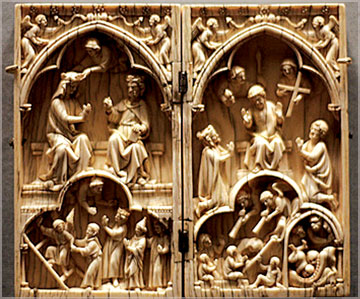Cloisters: Good place to start
Andrew Baker
I t was early March 2008, when I met a friend, and painter, for a
drink after work at a bar beneath Grand Central. He had just come from
the Whitney Biennial, which had recently opened. The experience had left
him drained and a bit cynical. I hadnít seen the show, but I knew the
feeling.
|

The building is a sort of amalgam comprising architectural
elements |
There are shows that leave you so invigorated that all you want is to
be back in the studio, feeling as though you could work through the
night without tiring. Then there are the shows that leave you empty,
pondering the foolish choices and childish ideals that led you to choose
the life of an artist. And you leave these shows knowing youíre supposed
to want to go back to work. But who can work when thereís so much
drinking to be done?
So we talked for a while over some beers about the things two
painters talk about when they feel the world is backwards and that
nobody makes art for the right reasons. And somewhere in there, we
realized that though weíd both lived as painters in the city for the
better part of a decade, neither of us had ever been to The Cloisters.
Finally, a problem that could be solved!
And so it happened that the following morning my friend and I met at
Columbus Circle, and headed north seeking some form of creative
purification or rejuvenation at a medieval monastery on the Upper West
Side of Manhattan.
If youíve never been to The Cloisters, itís really quite remarkable.
The subway lets you off outside the gates of Fort Tryon Park, which is a
gorgeous patch of hilly green overlooking the Hudson just to the north
of the George Washington Bridge. From there itís a bit of a hike through
the parkís gardens and wooded passes, and by the time you finally reach
the abbey youíre so taken out of your surroundings that itís almost a
surprise to realize that you havenít even left the city. Itís a feeling
you rarely get in any of the other major NYC parks, and for this place,
itís an appropriate sort of artifice. For itís there, hidden away at the
northern tip of Manhattan, that you can find a museum that houses what
is probably the greatest medieval art collection in the New World;
including, most famously, the Unicorn Tapestries.
|

The Merode Altarpiece by Robert Campin |
The building is a sort of amalgam comprising architectural elements
taken from various medieval European abbeys and transported to New York,
in the 1930s, by John D. Rockefeller Jr., for redesign by Charles
Collens. The interior is stone, and a bit cold. In the heart of the
building, thereís a 12th century arcade (hence: Cloisters) surrounding
an open-air garden, which is closed off during the colder months, as it
was then. At opposing ends of the garden, there are two chapels, built
centuries apart, lit by a cool expanse of ambient natural light. The
tapestries hang in more dimly lit rooms adjacent to the arcade, but the
bulk of the collection on display, e.g., illuminated manuscripts, ivory
carvings, early Flemish masterpieces, can be found on the lower floors.
We walked through this space with thoughts of the Biennial and of the
emptiness of its brand of celebrity still fresh in our minds. I stopped
before an elongated glass case that held a small ivory relief. There
were two panels with hinges in the center allowing it to open and close
like a book. Opened, the piece displayed four miniature scenes carved
into the ivory. On the left was the Coronation of the Virgin. On the
right: The Last Judgment. In the lower third of both panels, souls were
being lined up, the lucky being welcomed to Paradise, the rest were
being banished to damnation. It had been carved by an anonymous
Frenchman in the mid-13th century.
The Merode Altarpiece by Robert Campin may be the greatest painting
Iíve ever seen. Humbly displayed in a quiet room the color of limestone,
it sits on a perch and whispers, ďCome closer.Ē I obeyed, and I found a
picture Iíd seen a thousand times before in reproduction, but as is so
often the case, I had yet to really see it.
Three panels: the Annunciation of the Holy Motherhood by the Angel
Gabriel to the Virgin in the center, flanked on either side by devout
onlookers to the left and Joseph the Carpenter in his workshop to the
right. A technical marvel, itís masterfully rendered in oil from a time
when the medium was still in its infancy. I have yet to find a
reproduction that will do it justice, but the picture is revelation,
both literally and figuratively.
www.theatlantic.com |



